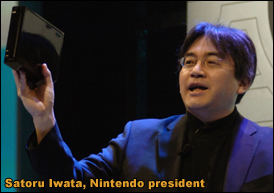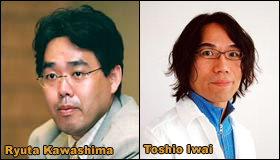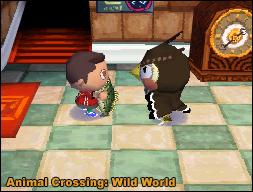|
 |
 |
 |

The DS: A Taste of Nintendo's Next Generation?
Page 1
|
|
 |
 |
|
|
 |
 |
 |
 "It should be a hint to the next generation of hardware." These were the words said by Nintendo President Satoru Iwata in an interview with Japanese newspaper Mainichi Shimbun way back in January of 2004, when the DS was first announced. Since then, comparisons between the DS and Wii, then code-named Revolution, were made, and statements of philosophy that are echoed for one echoed for both. Fans began to wonder what this could imply for Nintendo's next system: creating a new way to interact with games, power sacrificed for innovation and mass market affordability, creating software to attract a broader audience. That last part brings about many concerns amongst Nintendo fans, especially now that Nintendo has seen budding success in attracting new audiences. Will their philosophies of creating a "paradigm shift" (changing the current pattern of videogames) and the "Blue Ocean" strategy (exploring new avenues of videogames) alienate their age-old fans in favor of new ones? "It should be a hint to the next generation of hardware." These were the words said by Nintendo President Satoru Iwata in an interview with Japanese newspaper Mainichi Shimbun way back in January of 2004, when the DS was first announced. Since then, comparisons between the DS and Wii, then code-named Revolution, were made, and statements of philosophy that are echoed for one echoed for both. Fans began to wonder what this could imply for Nintendo's next system: creating a new way to interact with games, power sacrificed for innovation and mass market affordability, creating software to attract a broader audience. That last part brings about many concerns amongst Nintendo fans, especially now that Nintendo has seen budding success in attracting new audiences. Will their philosophies of creating a "paradigm shift" (changing the current pattern of videogames) and the "Blue Ocean" strategy (exploring new avenues of videogames) alienate their age-old fans in favor of new ones?
Nintendo said they were going to continue targeting the hardcore gamer and citing their franchises as examples. But even if they say that, wouldn't games like Brain Age and Nintendogs cause Nintendo to take redirect resources to devote to these new games, aimed at broadening the market? To take Nintendo's word that the DS is a sign of their next-generation hardware, let us look at what they have done with the games on their new innovative handheld. After all, actions speak louder than words. What we may see, is that not only are they not alienating fans, but they're going to do it while providing unique experiences for both us and newcomers.
|
|
 |
 |
|
|
 |
 |
 |
The "Non-Gamer's" Game
These are the hot topic of discussion: Brain Age, Animal Crossing: Wild World, Nintendogs, and Electroplankton, the former three of these four being successful titles. Meanwhile, Nintendogs and Electroplankton were focused on by Nintendo at last year's GDC and E3 and Brain Age was presented at this year's GDC. These are the causes of concern for veteran Nintendo fans, that the hardcore gamer is being abandoned in favor of Nintendo's "Blue Ocean" strategy. However, is that really the case?
First let us consider two of these four games: Brain Age and Electroplankton. There is one thing that both games have in common, and that's that both games were not only seemingly low-budget titles, but were also designed by people who are not game designers by trade. Electroplankton was designed by Toshio Iwai, an experimental artist in Japan who creates artistic devices based on lights and sound; Brain Age was designed by Ryuta Kawashima, a university professor in Japan who wrote a book on the theory of exercising the brain like a muscle to improve performance. These games didn't require the minds from Nintendo. There was no Miyamoto, no Tezuka, no Sakamoto, or any of the game designers and directors from Nintendo. These were games designed by people outside of the industry to bring in unique ideas into it.

Two "non-game designers" designing games for "non-gamers"
But then there are two other games, Nintendogs and Animal Crossing: Wild World. These were indeed developed at Nintendo, in fact by Nintendo's premiere studio EAD and with the names such as Shigeru Miyamoto, Takashi Tezuka and Hideki Konno attached to them. But there's more to the story behind them than just their appeal to "non-gamers." Animal Crossing: Wild World is a sequel. In fact, the series stretches back to the Nintendo 64, long before Nintendo started trumpeting the broadening of the gamer demographic and creating a "paradigm shift" in the industry. On the other hand, Nintendogs is the first of its series, but that doesn't mean that Nintendo redirected its resources to develop a "non-gamer's" game. A little-known fact is that Nintendogs was originally a Gamecube project that was moved to the DS. While it isn't hailing from the N64 days, the Gamecube was still not a product that's part of the "Blue Ocean" strategy, so we would've likely received the game anyway, regardless of Nintendo's newfound strategy. So what does this mean? That these two games, often mentioned as games that attract "non-gamers," were basically established well before the DS and Wii; it was just a fortunate coincidence that they both fit into Nintendo's goals quite well.

This series was hitting systems designed for core gamers,
long before Nintendo's new "non-gamer" philosophy
These titles don't just help to bring in new gamers though, as said before. They bring in new ideas as well. They bring in innovation, unique games that may otherwise not see the light of day. Gamers who are happy with the usual fair may not care, but for gamers looking for something new, these types of games may bring about even greater variety and innovation to the industry.
PAGE 1 - PAGE 2
|
|
 |
 |
|
|
|
 |
 |
 |
 |
// A mysterious character within the Banjo-Kazooie series was meant to star in his own N64 spin-off...
Click for more . . .
|
|
 |
 |
|
|
 |
 |
 |
 |
// Delve into the philosophical world of gaming in this Pikmin 2 special, Buried Treasures
Check it out . . .
|
|
 |
 |
|
|
 |
 |
 |
[an error occurred while processing this directive]
|
 |
 |
|
|
|























